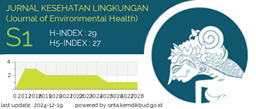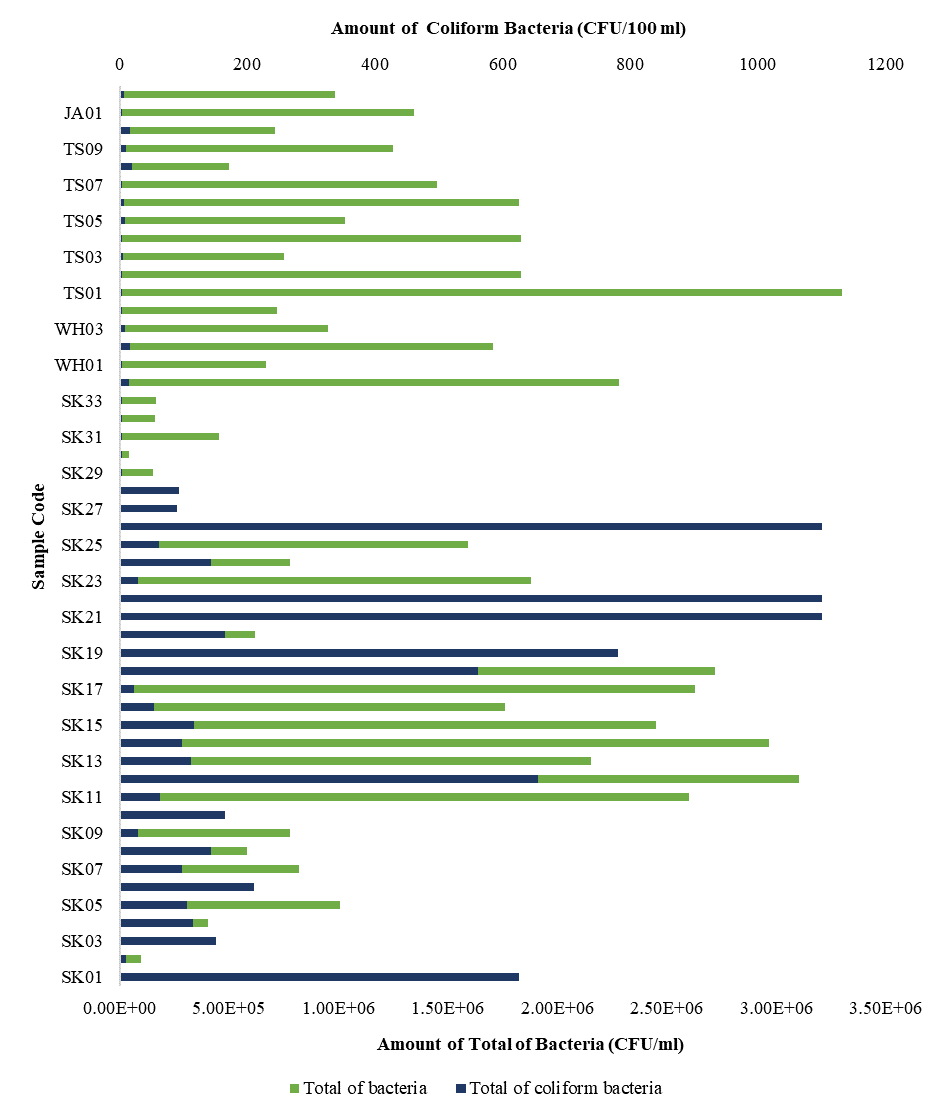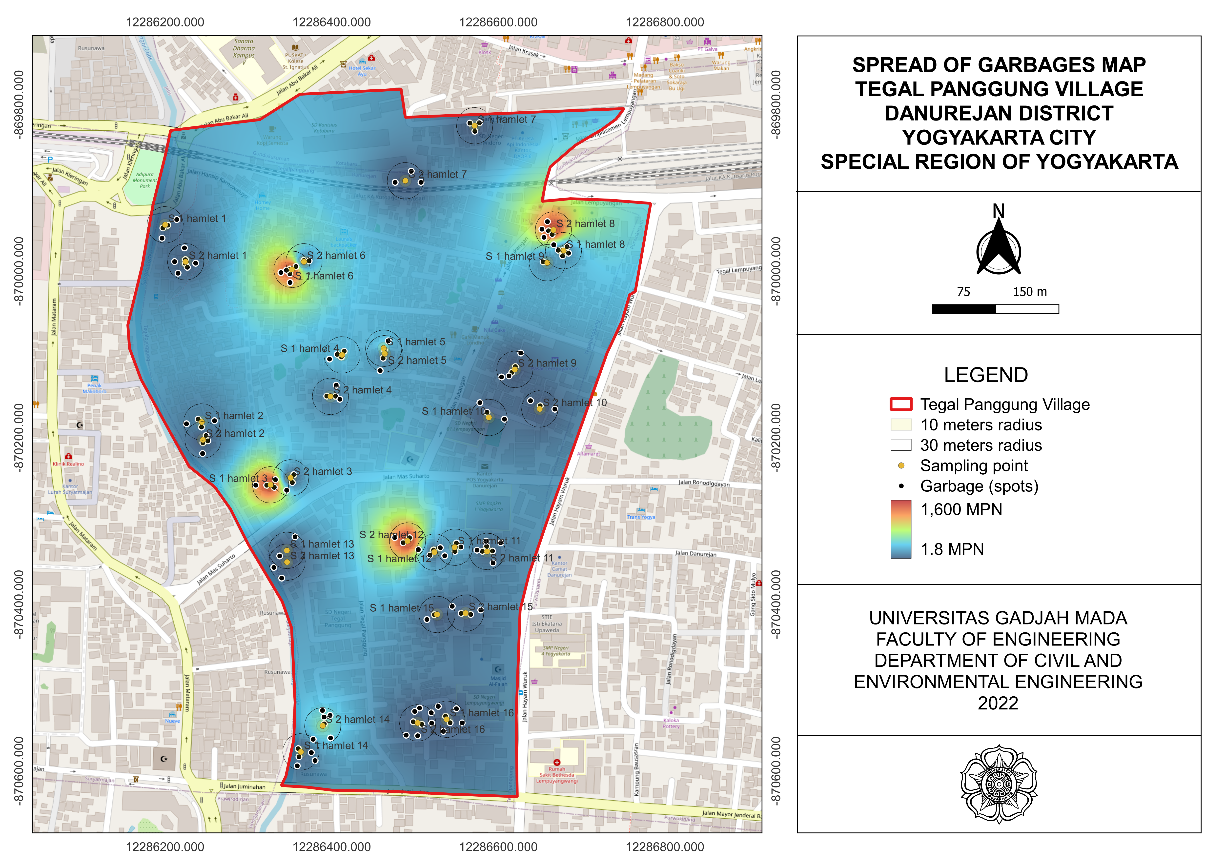Mapping And Analysis of Environmental Risk Factors Leptospirosis Incidence Based Geographic Information System (GIS) In Sampang Regency
Downloads
Abstract: One of the zoonosis in Indonesia is leptospirosis. Leptospirosis is caused due to infection of bacteria Leptospira. There were 107 cases and 9 deaths due to leptospirosis in Sampang. The incidence of leptospirosis in Sampang was an outbreak. The purpose of this study was to map the distribution of leptospirosis cases in Sampang in 2013 and to analyze environmental risk factors of leptospirosis cases (rainfall, altitude, and the presence of flood). This study was an observational-descriptive study and used cross-sectional study design. The unit of analysis of the study was administrative regions based on the districts. There was patients of leptospirosis in 4 districts in Sampang regency, there are Sampang district, Camplong district Robatal district and Omben district. The highest incidence of leptospirosis in Sampang regency was occured in Sampang district with rainfall more than 177.6 mm, altitude less than 47mdpl, and had experienced flooding. Mapping the incidence of leptospirosis showed the distribution of leptospirosis cases tend to be concentrated in Sampang district which had a history of flooding status. The conclusion is rainfall, altitude, and presence of flood are risk factors of leptospirosis. The advice is to improve surveillance of patients with leptospirosis particularly during floods, to do outreach to the community, to perform cross-sector cooperation, to avoid or to reduce the frequency of direct contact with the flood to minimize transmission of leptospirosis.
Keywords: leptospirosis incidence, risk factors, mapping
BPS Kabupaten Sampang. 2013. Sampang dalam Angka
Surabaya: BPS.
Badan Penanggulangan Bencana Daerah Kabupaten Sampang. 2013. Data Bencana Alam Banjir . Sampang: BPBD Kabupaten Sampang.
Barcellos C, Sabroza P.C. 2001. The Place Behind the Case; Leptospirosis Risks and Associated Environmental Conditions in a Flood-Related Outbreak in Rio de Janeiro, Cad. Saúde Pública, Rio de Janeiro, 59–67.
BBTKLPP Surabaya. 2013. Laporan Hasil Pengujian
Laboratorium. Surabaya: BBTKLPP Surabaya.
Chin, J. 2000. Control of Communicable Disease Manual:
th Edition. Washington: American Public Health Association.
Dinkes Kabupaten Sampang. 2013. Data Kejadian Leptospirosis di Kabupaten Sampang. Sampang: Dinkes Kabupaten Sampang.
Dinas Pekerjaan Umum Pengairan Kabupaten Sampang,
Laporan Kejadian Bencana. Sampang: Dinas
PU Pengairan Kabupaten Sampang.
Dinkes Provinsi Jawa Timur, 2013. Bulletin Epidemiologi Jawa Timur. Surabaya: Dinkes Provinsi Jawa Timur Dinkes Provinsi Jawa Timur, 2013. Profil Kesehatan Provinsi Jawa Timur Tahun 2012.http://www.depkes.go.id/downloads/PROFIL_KES_PROVINSI_2012/15_ Profil_Kes.Prov.JawaTimur_2012.pdf (sitasi 26 Maret 2014).
Juniarsih, 2012. Faktor Risiko dengan Pendekatan Spasial Temporal dalam Rangka Kewaspadaan Dini Kejadian Leptospirosis di Kabupaten Gresik. Thesis. Surabaya; Universitas Airlangga.
Irianto, R.Y, 2012. Kajian Deskriptif Kejadian Leptospirosis dengan Pendekatan SIG (Sistem Informasi Geografis) di Kota Semarang Tahun 2011. Skripsi. Semarang: Universitas Diponegoro.
Kemenkes R.I., 2011. Profil Kesehatan Indonesia Tahun 2011.http://www.depkes.go.id/downloads/ Profil_Data_Kesehatan_Indonesia_Tahun_2011.pdf (sitasi 28 November 2013).
Kemenkes R.I, 2004. Peraturan Menteri Kesehatan Republik Indonesia Nomor 949/MENKES/SK/ VIII/2004 Tentang Pedoman Penyelenggaraan Sistem Kewaspadaan Dini Kejadian Luar Biasa (KLB). http://www.hukor.depkes.go.id/up_prod_permenkes/ PMK%20No.%20949%20ttg%20P edoman%20
Penyelenggaraan%20Sistem%20Kewaspadaan%20
Dini%20KLB.pdf (sitasi 28 November 2013) Kemenkes RI, 2012. Peraturan Menteri Kesehatan Nomor 035 Tahun 2012 tentang Pedoman Identifikasi Faktor Risiko Kesehatan Akibat Perubahan Iklim. http:// www.djpp.kemenkumham.go.id/arsip/bn/2012/ bn914-2012lamp.pdf
Lau, Colleen. Lee D, Smythe. Scoot B, Craig. Philip Weinstein, 2010. Climate Change, Flooding, Urbanization And Leptospirosis:F uelling The Fire?. http://urbanag.wdfiles.com/local-
-files/forum%3Athread/CC%20flooding%20 urbanization%20disesase.pdf (sitasi 14 Juli 2014).
Mandal, B.K, E.G.L Wilkins, E.M Dunbar, R.T.M.White,
Lecture Notes: Penyakit Infeksi Edisi Keenam. Jakarta: Erlangga.
Sunaryo, 2009. Sistem Informasi Geografis untuk Pemetaan dan Penentuan Zona Kerawanan. Leptospirosis di Kota Semarang. http://eprints.undip. ac.id/19202/1/1OR04-Sunaryo-GIS-Leptospirosis.pdf (sitasi 16 Februari 2014)
Tiffani, S, 2011. Risiko Faktor Lingkungan terhadap Kajadian Leptospirosis di Surabaya. Skripsi. Surabaya: Universitas Airlangga.
WHO 2003. Human Leptospirosis: Guidance for
Diagnosis, Surveillance, and Control. Geneva
WHO.2013.ZoonosesLeptospirosis.http://www.who.int/zoonoses/diseases/leptospirosis/en/ (sitasi 21 November 2013).
W idoyono, 2011. P enyakit Tropis: Epidemiologi, Penularan, Pencegahan & Pemberantasannya Edisi Kedua. Jakarta: Erlangga.
Yudhastuti, R, 2011. Pengendalian Vektor dan Rodent.
Surabaya: Pustaka Melati.
2. Formal legal provisions to access digital articles of electronic journal are subject to the provision of the Creative Commons Attribution-ShareAlike license (CC BY-NC-SA), which means that Jurnal Kesehatan Lingkungan is rightful to keep, transfer media/format, manage in the form of databases, maintain, and publish articles.
3. Published manuscripts both printed and electronic are open access for educational, research, and library purposes. Additionally, the editorial board is not responsible for any violations of copyright law.
JKESLING by UNAIR is licensed under a Creative Commons Attribution-ShareAlike 4.0 International License.







































